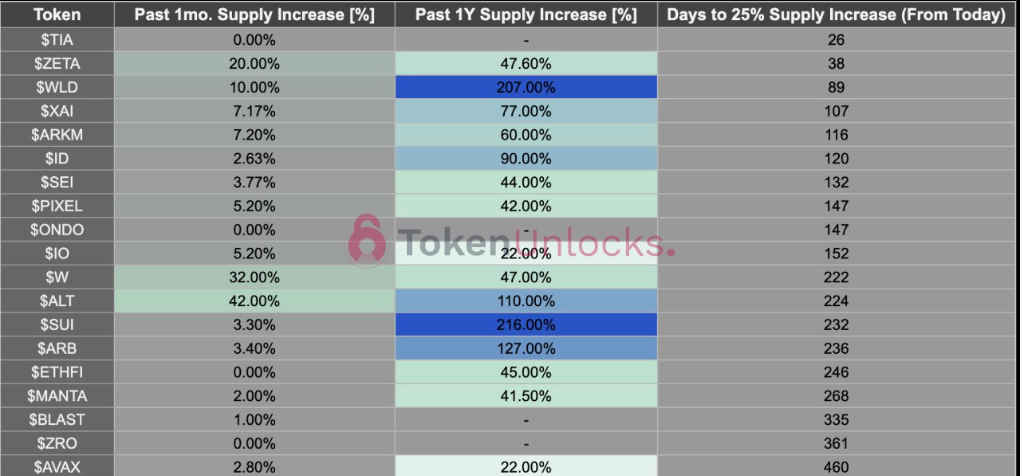- Token Unlocks data revealed the tokens with the highest supply increases over the past month and year.
- SUI, Worldcoin, AltLayer and Arbitrum have witnessed the highest yearly supply increases.
- ZETA and TIA will witness an additional 25% increase in supply within 26 and 38 days, respectively.
Token Unlocks data on Monday revealed that several tokens have witnessed high increases in their supply in the past month and over the last year. The statistics also show the number of days to a 25% supply for each of these tokens, with ZETA and TIA at the top of the list.
These are the tokens with the highest supply increase in the past year
According to a recent data from Token Unlocks, several tokens have seen the largest share of supply injection in the past year and over the last month.
Increasing circulating supply or impending heavy unlocks could negatively impact a token’s price, especially if demand fails to rise. Hence, it’s critical for investors to research a token’s supply dynamics before investing.
The token supply dynamics analyzed the historical trends from each of these tokens to reveal those with the highest supply injection within the monthly and yearly timeframes.
The tokens highlighted include TIA, ZETA, WLD, XAI, ARKM, ID, SEI, PIXEL, ONDO, IO, W, ALT, SUI, ARB, ETHFI, MANTA, BLAST, ZRO, and AVAX.
The category of tokens with the highest monthly supply injection include Wormhole (W), AltLayer (ALT), and Zeta (ZETA), with an inflation rate of 32%, 42%, and 20%, respectively. This increase in their circulating supply has impacted the price of these tokens, as they are all down more than 8% at the time of writing.
Sui (SUI) and Worldcoin (WLD) lead the category of tokens with the highest yearly supply growth, with one-year inflation rates of 216% and 207%, respectively.
Tokens with rising supply
Arbitrum (ARB) and AltLayer (ALT) follow right behind with 127% and 110% supply growth. Token Unlocks suggests that these surges in supply reflect significant year-on-year issuance.
Additionally, Token Unlocks’ analysis projects that ZETA and TIA will reach 25% of their supply within 26 and 38 days from today.
ZETA is set to release 15.7% of its current supply later in the week, which is worth $30 million. The token will experience high supply unlocks this week along with Optimism (OP) and Sui (SUI).
Cryptocurrency metrics FAQs
The developer or creator of each cryptocurrency decides on the total number of tokens that can be minted or issued. Only a certain number of these assets can be minted by mining, staking or other mechanisms. This is defined by the algorithm of the underlying blockchain technology. Since its inception, a total of 19,445,656 BTCs have been mined, which is the circulating supply of Bitcoin. On the other hand, circulating supply can also be decreased via actions such as burning tokens, or mistakenly sending assets to addresses of other incompatible blockchains.
Market capitalization is the result of multiplying the circulating supply of a certain asset by the asset’s current market value. For Bitcoin, the market capitalization at the beginning of August 2023 is above $570 billion, which is the result of the more than 19 million BTC in circulation multiplied by the Bitcoin price around $29,600.
Trading volume refers to the total number of tokens for a specific asset that has been transacted or exchanged between buyers and sellers within set trading hours, for example, 24 hours. It is used to gauge market sentiment, this metric combines all volumes on centralized exchanges and decentralized exchanges. Increasing trading volume often denotes the demand for a certain asset as more people are buying and selling the cryptocurrency.
Funding rates are a concept designed to encourage traders to take positions and ensure perpetual contract prices match spot markets. It defines a mechanism by exchanges to ensure that future prices and index prices periodic payments regularly converge. When the funding rate is positive, the price of the perpetual contract is higher than the mark price. This means traders who are bullish and have opened long positions pay traders who are in short positions. On the other hand, a negative funding rate means perpetual prices are below the mark price, and hence traders with short positions pay traders who have opened long positions.


